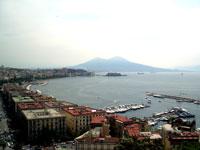
Italy's third-largest city thrives on the chaos that prevails amid its busy streets. This is the place where pizza was invented, and its restaurants continue to serve some of Italy's finest cuisine.
Sheltered by the Bay of Naples and dominated by the slopes of Mount Vesuvius, Naples is imbued with the best of nature's bounty. The city is somewhat schizophrenic in its juxtaposition of superb museums and Renaissance and Baroque churches alongside crumbling tenement blocks and squalor. Noisy markets sell a collection of items, from high-quality fresh produce to fake designer goods. Roads are characteristically hectic with gung-ho moped drivers weaving wildly through the streets and frustrating traffic jams clogging the city's arteries. Despite these less refined elements, Naples is a fascinating destination and a great base from which to explore popular attractions like the Amalfi Coast, Pompeii and Herculaneum.
The city's transport hub is located around the immense Piazza Garibaldi, on the east side of Naples. The area's growing African population has imbued the streets with the flavours of its immigrants. Southwest from here is the Piazza Bovio, and branching to the left of it, the Piazza Municipio and nearby Piazza del Plebiscito. On the watery edges are the Molo Beverollo and the Stazione Marittima, the point of departure for ferries. From the reaches of Spaccanapoli one can explore the historic part of Naples with its numerous palaces and churches.

Travel Guide powered by Word Travels, copyright © 2023 Globe Media Ltd. By its very nature information in this travel guide is subject to change at short notice and travellers are urged to verify information on which they're relying with the relevant authorities. Neither Globe Media Ltd nor Travel Vogue can accept any responsibility for any loss or inconvenience to any person as a result of information contained above.